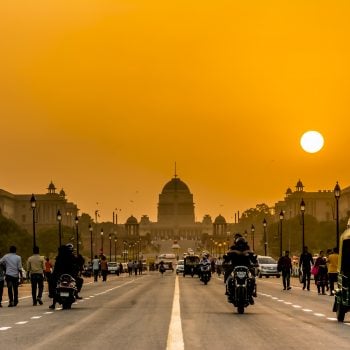An Ambition for Growth: The Roots of India’s Economic Miracle
Currently locked in a peculiar species of death roll with her backbenchers, Theresa May still (to her credit) seems intent on securing an orderly exit from the EU by 2020, but most economic commentators are forecasting a long term decline in UK GDP however “soft” the exit terms might be. Price Waterhouse for one are predicting that within a decade of exit, by 2030 the United Kingdom will have fallen to tenth place in Global GDP, behind Mexico and Indonesia and a whisker ahead of Turkey and France (which has a certain irony in the circumstances). And the same survey predicts that by 2030 India will have risen to third place in the global league, treading hard on the heels of China and the United States in first and second place respectively. But unlike the former mother country there is no suggestion that the subcontinent’s remorseless ambition for growth will lose any of its momentum over the course of the next half century.
China had better watch out…
The subcontinent’s economic ambition has been powered by a combination of progressive (some might say revolutionary) economic policies on the part of Prime Minister Modi’s Government (think demonetisation), coupled with a burgeoning and increasingly middle class population fuelling an unprecedented surge in consumer demand. But in a subtle and complex take on that dynamic, McKinsey this month published a fascinating report concluding that India’s explosive growth has just as much to do with interlocking trends in agriculture, urbanisation and mobility.
Take the first element in that triumvirate: agriculture. For decades now (at least the last thirty years), India has pursued an aggressive policy of agricultural self-sufficiency which has not only made the farming lobby one of the most powerful political forces in the country but has also delivered growth rates in the sector that are the envy of most of its near neighbours (indeed, the envy of most farmers anywhere in the world). But despite this, as McKinsey also point out, Indian agriculture still faces a spectrum of uniquely local challenges: severe water shortages alternating with devastating monsoons, combined with often antiquated supply structures and what McKinsey quaintly call a “limited exposure to high productivity practices”: in other words, a lack of investment in the latest farming technology.
That’s where the subtlety comes in…The Indian Government has re-calibrated its agricultural policy to shift the emphasis away from output targets, replacing them with a system of local subsidies designed to buttress farmers’ income (a policy that roused the never less than exuberant President Trump to bring proceedings against India again before the WTO). It was a smart shift in direction too because the new policy will almost certainly double agricultural wage rates by 2022 and, in a characteristically Keynesian frame of mind, the Modi Government are betting that with more money in their pockets India’s farmers will now start investing more in new technology. It can’t do much to stop monsoons but it can, as McKinsey would no doubt put it, “increase exposure to high productivity practices”.
That same factor feeds into the second limb of McKinsey’s triumvirate: urbanisation. More than 200 Million of India’s rural population are expected to move into its urban conurbations over the next 15 years and for those with the instinct to move rather than invest locally, improved agricultural subsidies are giving them a store of money to do it with. And, the Modi Administration is playing to its strengths on this too with a new Smart Cities Mission designed to meet the additional, affordable housing required to cope with resulting surges in demand, reducing urban pollution levels and increasing resource productivity and economic development through enhanced infrastructure programmes. You don’t need to look any further to find the real roots of India’s economic miracle.
And what about mobility: the third element of the McKinsey triumvirate? Well, that’s coming along nicely too with India now expected to become the world’s third largest passenger vehicle market by 2021. It’s not just that the subcontinent offers the same, parallel opportunities and challenges as other western and developing markets, it is offering them with a turbo charger attached. Many of those 200 Million people who are moving from village to town over the next 15 years will want (and get) a car, paying for it with the increased wages earned from working on all those new infrastructure projects; and their family and friends who stayed in the country and invested in new agricultural technology will probably want (and get) a new car too. You need to keep up with your cousins in town!
That, in essence, is what we mean by an interlocking economic structure, and it’s here that we can find the real roots of India’s explosive growth. Just wait to see what happens next…
Nobody understands that potential for growth better than Red Ribbon Asset Management, which has placed India at the very heart of its investment strategies since the company was founded more than a decade ago. With an unrivalled knowledge of market conditions on the subcontinent, Red Ribbon offers a unique opportunity to share in that vast potential.
[nectar_btn size="large" open_new_tab="true" button_style="regular" button_color_2="Accent-Color" icon_family="none" url="https://ecohotels.in/ordinary_shares" text="Invest in Pre-IPO opportunity in Eco Hotels"][nectar_btn size="large" open_new_tab="true" button_style="regular" button_color_2="Accent-Color" icon_family="none" url="https://modulexglobal.com/ordinary_shares" text="Invest in Pre-IPO opportunity in Modulex"]
Red Ribbon CEO, Suchit Punnose said:
At Red Ribbon we are very proud to have been playing our own part in India’s economic resurgence over the last decade, investing in just the kind of projects that are at the heart of the interlocking triangle of growth mentioned in the article: everything from the modular construction technologies now being developed by Modulex so as to deliver affordable housing at the pace demanded by the subcontinent’s urban expansion, through to innovative sustainable energy infrastructure investment. And to see India now firmly established at its place on the economic top table, uniquely well placed to move further forward still is, of course, a particular source of pride for us.
We look forward to continuing to play our part in India’s future, participating to the utmost in the opportunities the subcontinent’s explosive growth has to offer and at the same time providing above market rate returns from our investors in what I am convinced will continue to be one of the world’s most exciting markets for many years to come.
[social_buttons full_width_icons="true" facebook="true" twitter="true" google_plus="true" linkedin="true" pinterest="true"]








Leave a Reply